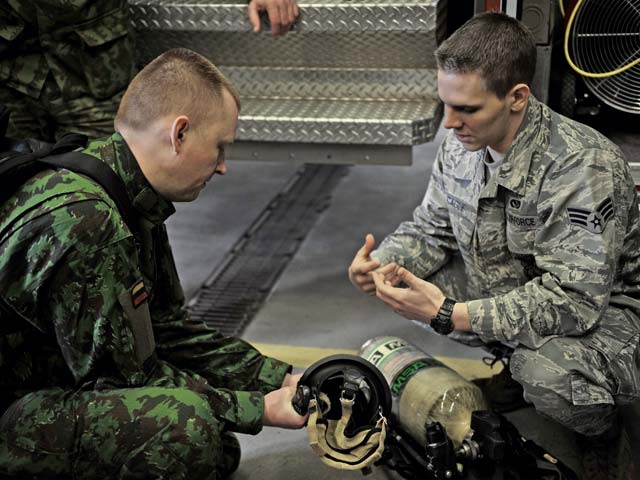
A Firefighter Fundamentals Course was held for a group of Lithuanian and Bosnian military members March 10 through 14 at the 435th Construction and Training Squadron.
The course consisted of hands-on simulations and classroom portions to learn about different fire rescue techniques.
“The majority of the curriculum has been crash fire rescue,” said Tech. Sgt. James Hickman, 435th Construction and Training Squadron contingency and rescue training NCOIC. “We have been adding several elements like command and control of the scene, mitigation of types of emergencies they will see as well as rope rescue and some medical training.”
The day started in a classroom explaining any aircraft hazards, shut down procedures, tactics, aircraft set up and differences between cargo, fighter and rotary wing aircraft to the Lithuanians and Bosnians.
“For this course we got members from Lithuania and Bosnia together with our 435th CTS fire academy cadre in order to teach them firefighting fundamentals,” said Tech. Sgt. Brandon Williams, 435th Contingency Response Group air adviser. “During the course they are going to get a lot of hands-on training with the simulators and learn tactics and procedures, which can help increase their firefighting capacity and their interoperability.”
The 435th CRG has a special team assigned to coordinate these missions, called the air adviser branch.
“As an air adviser, we help facilitate these missions between our allies and partners to enhance their capabilities,” said Staff Sgt. Tracy Parks, 435th CRG air adviser.
The air adviser branch aims to keep these missions going throughout the year, having as many as six missions in a month.
“It’s important to do things with other countries, because we might learn something new about them that we weren’t sure of before,” Parks said. “It creates a foundation and a bond going forward into the future.”
Both countries’ representatives asked a great deal of questions, were hands-on and exchanged information to enhance their own capabilities.
“My favorite part is trading information and finding out that we can relate to these countries thousands of miles away,” Hickman said. “In the firefighter and rescue world we do things similarly, and we essentially speak the same language, which helps get the mission done that much better.”


